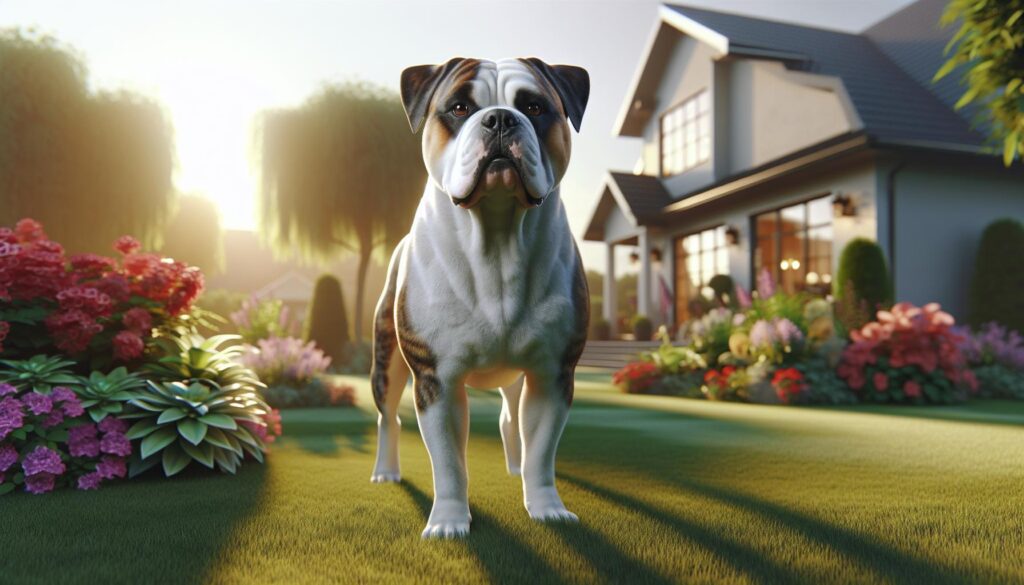”
I’ve always been fascinated by the American Bulldog’s unique blend of strength and gentleness. As a powerful working breed with a rich history dating back to the American South these dogs have evolved from their original role as farm dogs to become beloved family companions.
When I think about American Bulldogs I’m reminded of their incredible versatility. These muscular yet agile dogs stand out with their distinctive white coats often marked with patches of brindle red or black. While they might look intimidating at first glance I’ve discovered they’re actually some of the most affectionate and loyal breeds you’ll ever meet.
Key Takeaways
- American Bulldogs are powerful working dogs that combine strength with gentleness, standing 20-28 inches tall and weighing 60-100 pounds depending on gender
- The breed features two main types: the larger Johnson (Classic) and the more athletic Scott (Standard), both recognized by the UKC in 1999
- These dogs require 60-90 minutes of daily exercise and consistent training using positive reinforcement methods for optimal behavior
- Common health concerns include hip dysplasia, NCL, and eye conditions, necessitating regular veterinary check-ups and health screenings
- Early socialization (3-16 weeks) and structured training are crucial for developing well-adjusted American Bulldogs
- While protective of family, American Bulldogs are intelligent, trainable, and make excellent family companions when properly trained and exercised
American:n_fqsiqmg14= Bulldog
American Bulldogs display distinct physical features coupled with a unique personality profile. The breed showcases a perfect balance between power and agility, making them versatile working dogs.
Physical Characteristics
American Bulldogs exhibit a muscular build with a large head and broad chest. Adult males stand 22-28 inches tall weighing 75-100 pounds, while females measure 20-25 inches reaching 60-80 pounds. Notable features include:
- Square-shaped head with pronounced cheek muscles
- Strong jaw with a slight underbite
- Well-defined shoulders with thick bone structure
- Deep chest cavity with visible muscle definition
- Short coat in white with patches of brindle, black or brown
| Feature | Male | Female |
|---|---|---|
| Height | 22-28 inches | 20-25 inches |
| Weight | 75-100 lbs | 60-80 lbs |
| Chest Width | 25-35 inches | 23-32 inches |
Temperament and Personality
American Bulldogs combine confidence with a gentle disposition toward family members. Their behavioral traits include:
- Strong protective instincts toward family members
- High energy levels requiring regular exercise
- Intelligence with quick learning capabilities
- Social nature with proper early socialization
- Patience with children in family settings
- Alert watchdog characteristics without excessive barking
These dogs excel in structured environments with clear boundaries. They form strong bonds with their primary caregiver while maintaining friendly relationships with all family members. Early training establishes proper social behaviors critical for their development.
History and Origins of the American Bulldog
The American Bulldog traces its lineage to the 17th century working dogs brought by English immigrants to the American South. These early bulldogs served as all-purpose farm dogs, specializing in catching feral cattle, protecting property from predators, and hunting wild boar.
During the post-Civil War era, the breed nearly faced extinction. Credit for preserving the American Bulldog goes to John D. Johnson and Alan Scott, who developed two distinct types:
- Johnson Type (Classic): Larger, heavier-built dogs with broader heads
- Scott Type (Standard): More athletic, lighter-framed dogs with narrower muzzles
| Time Period | Key Development |
|---|---|
| 1600s | English Bulldogs arrive in America |
| 1800s | Breed evolves for farm work |
| 1940s | Johnson begins breeding program |
| 1960s | Scott develops standard type |
| 1999 | UKC recognition achieved |
The breed maintained its working heritage in rural areas, particularly Georgia, Alabama, and South Carolina. These dogs performed essential tasks:
- Catching escaped livestock
- Guarding property against intruders
- Controlling destructive wild hogs
- Assisting with general farm work
The American Bulldog gained official recognition from the United Kennel Club in 1999. The breed’s registration numbers demonstrate its growing popularity:
| Year | Registered Dogs |
|---|---|
| 2000 | 3,500 |
| 2010 | 12,000 |
| 2020 | 25,000 |
- Family guardians
- Police work
- Search and rescue
- Competitive sports
Health Considerations for American Bulldogs
American Bulldogs require specific health monitoring due to their genetic predisposition to certain conditions. Their robust build demands regular veterinary care to maintain optimal health.
Common Medical Issues
American Bulldogs face several breed-specific health challenges:
- Hip dysplasia affects 18.4% of American Bulldogs based on OFA statistics
- Neuronal ceroid lipofuscinosis (NCL), a genetic disorder causing nervous system deterioration
- Cherry eye, a condition where the third eyelid gland protrudes
- Bone cancer, particularly osteosarcoma in larger specimens
- Entropion, an inward rolling of the eyelid that irritates the cornea
- Thyroid disorders affecting metabolism regulation
- Elbow dysplasia causing joint inflammation and mobility issues
- Schedule bi-annual veterinary checkups for early detection of health issues
- Maintain weight between 75-100 pounds for males 60-80 pounds for females
- Exercise 60 minutes daily through walks jogging or play sessions
- Clean facial wrinkles 3 times weekly to prevent bacterial growth
- Brush teeth 2-3 times weekly using enzymatic toothpaste
- Monitor joint health through regular mobility assessments
- Complete hip x-rays at 24 months to screen for dysplasia
- Perform genetic testing for NCL before breeding
- Update vaccinations every 12 months per veterinary guidelines
| Health Screening | Recommended Age | Frequency |
|---|---|---|
| Hip Evaluation | 24 months | Once |
| Eye Examination | 12 months | Annually |
| Thyroid Testing | 24 months | Every 2 years |
| Cardiac Exam | 12 months | Annually |
Training and Socialization
American Bulldogs respond exceptionally well to structured training programs that establish clear leadership roles. Their intelligence combined with an eager-to-please attitude makes them highly trainable companions when using positive reinforcement techniques.
Basic Obedience Training
Training an American Bulldog starts with essential commands like sit, stay, come, and leash walking. I emphasize establishing consistent routines through 15-minute daily training sessions focusing on one command at a time. Positive reinforcement methods include:
- Using high-value treats (chicken, cheese, beef) to reward desired behaviors
- Implementing clicker training for precise timing of rewards
- Teaching impulse control through “”wait”” exercises before meals
- Practicing leash manners in different environments (parks, streets, yards)
- Reinforcing recall commands with long-lead training exercises
Early Socialization Needs
Proper socialization between 3-16 weeks shapes an American Bulldog’s future behavior patterns. I recommend exposing puppies to:
- Various people (children, adults, seniors)
- Different animals (dogs, cats, livestock)
- Multiple environments (urban areas, parks, veterinary clinics)
- Diverse sounds (traffic, machinery, household appliances)
- Different surfaces (grass, concrete, metal grates, wooden floors)
- Controlled puppy playdates with vaccinated dogs
- Brief visits to pet-friendly stores
- Walking on different terrains
- Gentle handling by multiple family members
- Introduction to grooming tools and procedures
Living with an American Bulldog
American Bulldogs thrive in homes with structured routines and regular physical activity. These powerful dogs adapt well to various living environments, from spacious houses to apartments with adequate exercise opportunities.
Exercise Requirements
An American Bulldog needs 60-90 minutes of daily exercise through activities like:
- Walking or jogging 2-3 miles per day
- Playing fetch in a fenced yard for 20-30 minutes
- Swimming sessions twice weekly during warm months
- Agility training or obstacle courses twice weekly
- Tug-of-war games using durable rope toys
- Interactive play sessions with puzzle toys
- Brushing twice weekly with a rubber curry brush
- Bathing every 8-10 weeks using dog-specific shampoo
- Cleaning facial wrinkles 2-3 times weekly with unscented wipes
- Trimming nails every 3-4 weeks
- Brushing teeth 2-3 times weekly
- Professional grooming visits quarterly
| Grooming Task | Frequency | Tools Needed |
|---|---|---|
| Brushing | 2x weekly | Rubber curry brush |
| Bathing | Every 8-10 weeks | Dog shampoo |
| Wrinkle cleaning | 2-3x weekly | Unscented wipes |
| Nail trimming | Every 3-4 weeks | Nail clippers |
| Teeth brushing | 2-3x weekly | Dog toothbrush & paste |
| Professional grooming | Every 3 months | N/A |
Blend of Strength and Sensitivity.
I’ve found that American Bulldogs truly embody the perfect blend of strength and sensitivity. Their unwavering loyalty paired with their gentle nature makes them exceptional family companions when properly trained and socialized.
From their humble beginnings as farm dogs to their current status as beloved pets these remarkable dogs continue to prove their versatility. Their robust health management needs and exercise requirements might seem demanding but the rewards of sharing your life with such a devoted and capable companion are immeasurable.
It’s clear that an American Bulldog can be an outstanding addition to the right home especially for those ready to invest time in training and provide the structure these intelligent dogs need to thrive.


